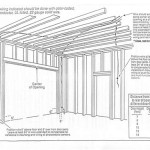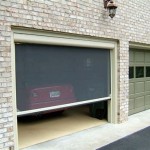The Perfect Size For Your Single Car Garage Door Opener
Selecting the correct garage door opener for a single-car garage involves understanding the interplay between several key factors. These factors primarily revolve around the door's weight and size, the intended frequency of use, and the specific features desired by the homeowner. Choosing an undersized opener can lead to premature wear and tear, compromised safety, and frustrating operational failures. Conversely, an oversized opener may represent an unnecessary expense and could potentially damage a lighter door if not calibrated carefully.
The performance of a garage door opener is directly tied to its horsepower (HP) rating. This rating indicates the motor's strength and ability to lift and lower a particular weight. Single-car garage doors typically weigh between 130 and 400 pounds, depending on the material and construction. Therefore, the horsepower requirement will vary significantly. Ignoring this crucial aspect can result in an unreliable and short-lived garage door opener.
Beyond horsepower, other factors like the drive system (chain, belt, screw) and the inclusion of safety features also contribute to the overall effectiveness and longevity of the opener. A well-chosen opener should provide smooth, quiet, and reliable operation while adhering to the necessary safety standards.
Determining the Appropriate Horsepower
The first and most crucial step in selecting a garage door opener is accurately determining the appropriate horsepower. While 1/2 HP openers are often considered standard for single-car garages, this recommendation is not universally applicable. The weight and material of the garage door are paramount in this decision. For lightweight aluminum or steel doors weighing less than 250 pounds, a 1/2 HP opener is generally sufficient. However, heavier doors, particularly those made of wood or insulated steel, will require a more powerful opener, typically in the 3/4 HP range.
The door's material composition significantly impacts its weight. Wood doors, especially those made of solid wood, are considerably heavier than their aluminum or steel counterparts. Insulated doors, designed to improve energy efficiency, also add substantial weight due to the insulation material used. Accurately assessing the door's weight is essential to avoid overstressing the opener's motor.
In situations where the door is particularly heavy or exceptionally well-insulated, a 1 HP opener may be considered. While seemingly excessive for a single-car garage door, it can provide an added margin of safety and reliability, particularly in climates with extreme temperature fluctuations. Temperature variations can affect the door's weight and the lubrication of its moving parts, potentially straining a less powerful opener.
It is always advisable to err on the side of caution and choose a slightly more powerful opener than initially assessed. An underpowered opener will struggle to lift the door, leading to increased wear and tear, overheating, and premature failure. A slightly overpowered opener, on the other hand, will operate more efficiently, experience less strain, and potentially extend its lifespan.
Understanding Different Drive Systems
Garage door openers employ various drive systems to transfer power from the motor to the door. The three most common types are chain drive, belt drive, and screw drive. Each system offers distinct advantages and disadvantages regarding noise level, maintenance requirements, and cost.
Chain drive openers are the most common and generally the most affordable. They utilize a chain to pull the door along a track. While highly durable and capable of handling heavy doors, chain drive openers are also the loudest option. The metal-on-metal contact of the chain generates significant noise, which can be a concern in garages attached to living spaces.
Belt drive openers offer a quieter alternative to chain drives. Instead of a chain, they use a rubber or reinforced belt to lift the door. The belt's smooth and flexible nature significantly reduces noise and vibration, making them ideal for homeowners seeking a more discreet operation. However, belt drive openers are typically more expensive than chain drives and may not be as robust for particularly heavy doors.
Screw drive openers utilize a threaded steel rod to move the door. They offer a good balance of noise level and durability but require regular lubrication to ensure smooth operation. Screw drive openers are generally more expensive than chain drive openers but can be a viable option for those seeking a mid-range solution.
The choice of drive system depends on individual preferences and priorities. Homeowners prioritizing affordability and durability may opt for a chain drive, while those seeking a quieter operation may prefer a belt drive. Screw drive openers offer a compromise between these two options. The size and weight of the door can also influence the choice, as heavier doors may require the robustness of a chain drive.
Essential Safety Features and Considerations
Safety is of paramount importance when selecting a garage door opener. Modern garage door openers are equipped with several safety features designed to prevent accidents and injuries. Understanding and utilizing these features is crucial for ensuring the safety of occupants and property.
The most critical safety feature is the photoelectric eye system. This system consists of two sensors positioned near the bottom of the door opening. These sensors emit an invisible beam of light across the doorway. If an obstruction disrupts the beam while the door is closing, the opener automatically reverses the door's direction, preventing it from closing on the obstruction.
Another essential safety feature is the force setting. This setting allows the homeowner to adjust the amount of force the opener exerts when closing the door. If the door encounters an obstruction, the force setting should be low enough to prevent injury or damage. The force setting should be tested regularly to ensure it is functioning correctly.
Manual release mechanisms are also vital in case of power outages or opener malfunctions. These mechanisms allow homeowners to disconnect the door from the opener and operate it manually. Familiarizing oneself with the manual release mechanism and practicing its operation is crucial for emergency situations.
Beyond these standard safety features, some openers offer additional functionalities, such as battery backup systems. These systems ensure the opener can continue to operate even during power outages. Another feature is the inclusion of rolling codes, which change the access code each time the opener is used, preventing unauthorized access.
Regular maintenance and inspection of the garage door opener are also essential for ensuring its safe and reliable operation. This includes lubricating moving parts, checking for loose connections, and testing the safety features regularly. Neglecting maintenance can lead to malfunctions and compromise the safety of the opener.
In conclusion, selecting the perfect size garage door opener involves a thorough assessment of the door's weight and material, consideration of the desired drive system, and a focus on essential safety features. By carefully evaluating these factors, homeowners can choose an opener that provides reliable, safe, and convenient operation for years to come.

How To Determine The Garage Door Opener Size You Need

Standard Garage Door Sizes Single Double Roller Doors Sectional

How To Determine The Garage Door Opener Size You Need

What Size Garage Door Do I Need Guide Easy Open

An Introduction To Garage Door Sizes Continental

Standard Garage Door Sizes And Considerations Spectrum Ohd

Your Guide To Standard Garage Door Dimensions

How To Measure For Your New Residential Garage Door Ideal

What Are The Standard Garage Door Sizes Clopay
.jpg?strip=all)
Garage Door Sizes And Measurements Up Over Sectional Roller Shutter Side Hinged Garages
Related Posts








